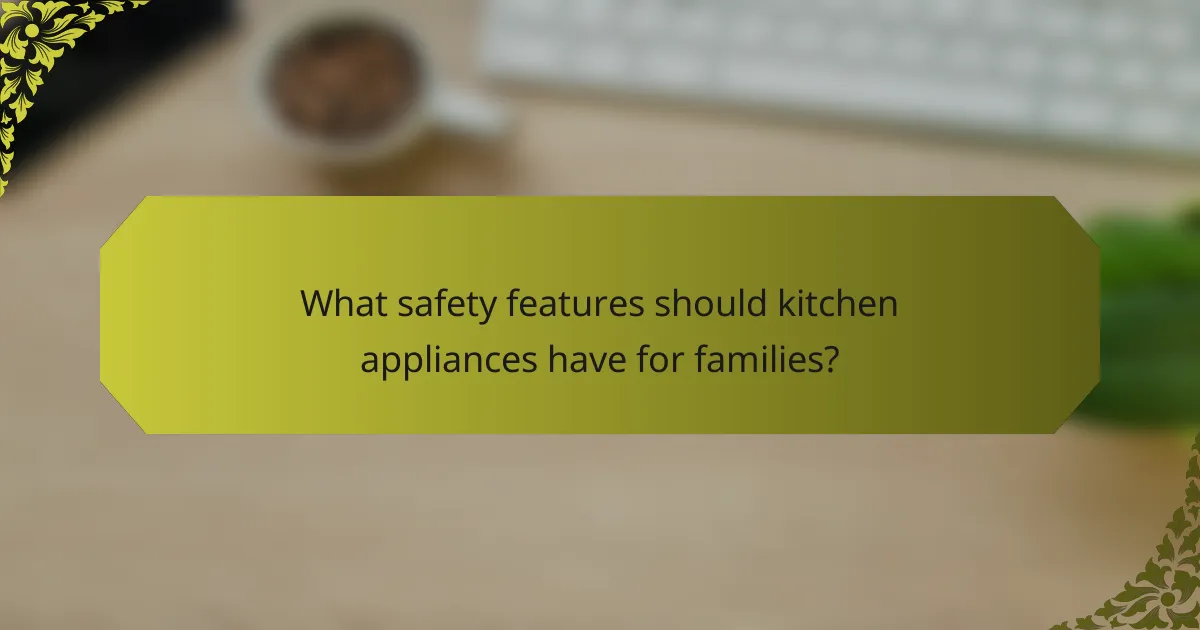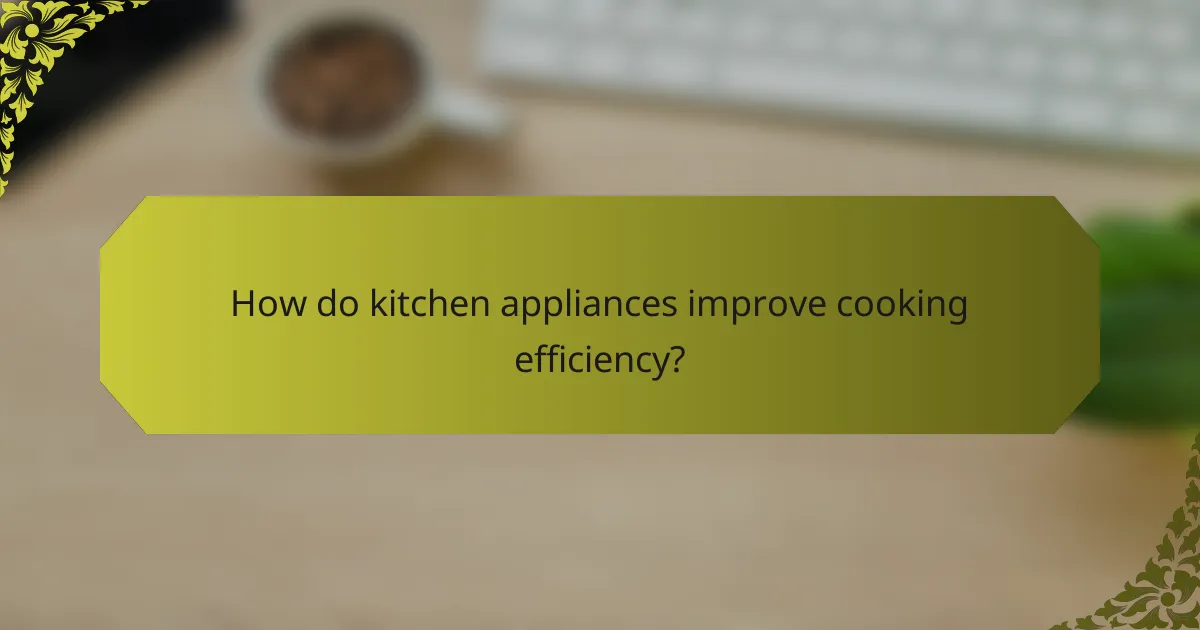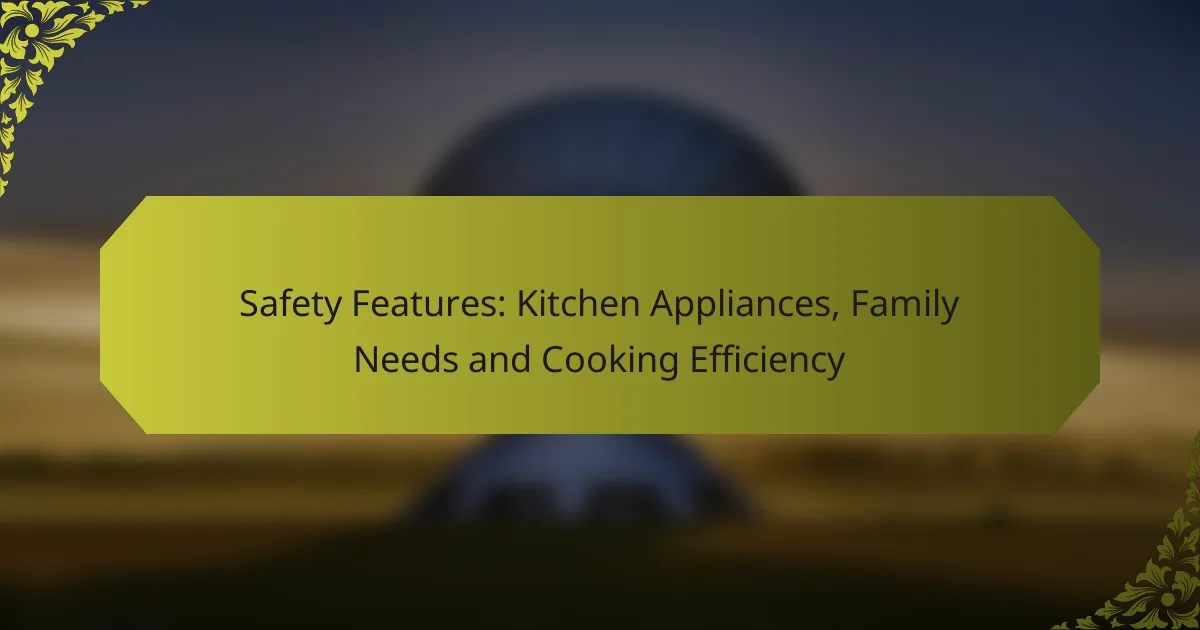When selecting kitchen appliances for families, prioritizing safety features is essential to create a secure cooking environment. Innovations such as child locks, auto shut-off mechanisms, and heat-resistant materials significantly reduce risks, particularly for households with children. Additionally, modern appliances enhance cooking efficiency by streamlining tasks and minimizing preparation time, allowing families to enjoy meals with less effort.

What safety features should kitchen appliances have for families?
Kitchen appliances designed for families should include safety features that minimize risks, especially for children. Key features like child locks, auto shut-off, and heat-resistant materials help ensure a safer cooking environment.
Child lock mechanisms
Child lock mechanisms are essential for preventing children from accidentally operating appliances. These locks can be activated with a simple button press or switch, ensuring that only adults can access the appliance’s functions. Look for models that offer a reliable locking system to enhance safety.
When selecting appliances, check for user-friendly child lock features that are easy for adults to engage but difficult for children to disengage. This can include touch controls that require a specific sequence to unlock.
Auto shut-off functions
Auto shut-off functions automatically turn off appliances after a set period of inactivity, reducing the risk of fires and overheating. This feature is particularly important for devices like toasters, ovens, and slow cookers, which can pose hazards if left unattended.
Choose appliances with adjustable shut-off times, allowing you to customize the duration based on your cooking needs. This flexibility can help prevent accidents while still accommodating various cooking styles.
Heat-resistant materials
Heat-resistant materials are crucial for kitchen appliances to withstand high temperatures without warping or melting. Look for appliances made from materials like stainless steel or high-grade plastics that are designed to endure heat exposure safely.
Additionally, ensure that any handles or knobs are made from heat-resistant materials to prevent burns during use. This is particularly important for items like pots, pans, and oven mitts that are frequently handled while cooking.
Safety sensors
Safety sensors can detect issues such as overheating, smoke, or gas leaks, providing an added layer of protection. Many modern appliances come equipped with these sensors, which can trigger alarms or automatic shut-off features to prevent accidents.
When purchasing appliances, consider those with built-in safety sensors that comply with safety standards. This can include smoke detectors in ovens or temperature sensors in cooktops that alert you to potential hazards.
Non-slip bases
Non-slip bases are important for ensuring that appliances remain stable during use, reducing the risk of spills or accidents. Look for appliances with rubberized or textured bases that grip countertops effectively.
In addition to preventing movement, non-slip bases can also protect your countertops from scratches and damage. This feature is especially beneficial for blenders, mixers, and food processors that may vibrate during operation.

How do kitchen appliances improve cooking efficiency?
Kitchen appliances enhance cooking efficiency by streamlining tasks, reducing preparation time, and optimizing energy use. With advancements in technology, modern appliances are designed to perform multiple functions quickly and effectively, allowing families to prepare meals with less effort and in shorter timeframes.
Smart technology integration
Smart kitchen appliances utilize internet connectivity and automation to simplify cooking processes. For instance, smart ovens can be preheated remotely, and refrigerators can monitor food freshness and suggest recipes based on available ingredients. This integration not only saves time but also helps in managing meal planning more effectively.
When choosing smart appliances, consider compatibility with your home network and the ease of use of accompanying apps. Look for features like voice control and programmable settings to maximize convenience.
Energy-efficient models
Energy-efficient kitchen appliances consume less electricity, which can lead to significant savings on utility bills over time. Look for models with high Energy Star ratings, which indicate compliance with energy efficiency standards. These appliances often use advanced technology to minimize energy consumption while maintaining performance.
Investing in energy-efficient appliances can reduce your carbon footprint and contribute to a more sustainable kitchen. For example, an energy-efficient dishwasher can use up to 50% less water and energy compared to older models.
Multi-function appliances
Multi-function appliances combine several cooking methods into one device, such as a pressure cooker that can also steam, sauté, and slow cook. This versatility not only saves space but also reduces the need for multiple appliances, making meal preparation quicker and more efficient.
When selecting a multi-function appliance, assess your cooking habits and choose one that fits your needs. Popular options include Instant Pots and air fryers, which can significantly cut down cooking times for various dishes.
Rapid heating elements
Rapid heating elements, found in induction cooktops and some modern ovens, heat up quickly and provide precise temperature control. This feature allows for faster cooking times and more efficient energy use compared to traditional heating methods.
Consider the benefits of induction cooking, which can boil water in just a few minutes and respond instantly to temperature adjustments. This technology not only enhances cooking efficiency but also improves safety by reducing the risk of burns and overheating.

What are the best kitchen appliances for family safety?
When considering kitchen appliances for family safety, look for features that minimize risks, such as automatic shut-off, cool-touch surfaces, and safety locks. Appliances like the Instant Pot Duo, Breville Smart Oven, KitchenAid Stand Mixer, and GE Profile Induction Cooktop are designed with these safety features in mind, making them suitable for households with children or pets.
Instant Pot Duo
The Instant Pot Duo is a versatile multi-cooker that combines several cooking functions, including pressure cooking and slow cooking, while prioritizing safety. It features a safety lock that prevents the lid from being opened while under pressure, reducing the risk of burns or spills.
Additionally, the Instant Pot Duo includes overheat protection and a steam release valve, which ensures safe pressure release. Families can benefit from its programmable settings, allowing for hands-free cooking while keeping children safe from hot surfaces.
Breville Smart Oven
The Breville Smart Oven is designed with safety in mind, featuring an automatic shut-off function that activates when the cooking cycle is complete. This helps prevent overheating and potential fire hazards, making it a reliable choice for busy families.
Its cool-touch exterior minimizes the risk of burns, while the internal light allows for easy monitoring without opening the door. The Smart Oven also includes a range of cooking presets, making it easy to prepare meals safely and efficiently.
KitchenAid Stand Mixer
The KitchenAid Stand Mixer is a staple in many kitchens, known for its durability and safety features. It includes a safety lock that prevents the mixer from operating unless the bowl is securely in place, reducing the risk of accidents.
Additionally, the mixer has a powerful motor that can handle heavy doughs without overheating, and its non-slip base ensures stability during operation. Families can enjoy baking with peace of mind, knowing that the mixer is designed for safe use.
GE Profile Induction Cooktop
The GE Profile Induction Cooktop offers a safe cooking experience through its induction technology, which heats pots and pans directly while keeping the surface cool to the touch. This significantly reduces the risk of burns, making it ideal for homes with children.
It also features automatic shut-off and child lock settings, ensuring that the cooktop cannot be accidentally activated. With precise temperature control, families can cook meals efficiently while maintaining a safe environment.

How to choose kitchen appliances based on family needs?
Selecting kitchen appliances that cater to your family’s needs involves understanding your household size, cooking habits, available space, and safety requirements. By evaluating these factors, you can make informed choices that enhance cooking efficiency and ensure safety in the kitchen.
Assess family size
Family size significantly influences the type and capacity of kitchen appliances you should consider. For smaller families, compact appliances may suffice, while larger families often require more substantial models to accommodate cooking for multiple people.
For example, a family of four might benefit from a refrigerator with a capacity of around 20 to 25 cubic feet, while a larger family could need one that exceeds 30 cubic feet. Always think about future needs, especially if your family is likely to grow.
Consider cooking habits
Your cooking habits play a crucial role in appliance selection. If your family enjoys home-cooked meals frequently, investing in high-quality appliances like a powerful oven or a multi-functional food processor can enhance your cooking experience.
Conversely, if your family relies on quick meals or takeout, simpler appliances, such as a microwave or toaster oven, may be more appropriate. Assess how often you cook and the types of meals you prepare to guide your choices.
Evaluate kitchen space
The available kitchen space is a vital factor when choosing appliances. Measure your kitchen layout and consider the dimensions of potential appliances to ensure they fit comfortably without overcrowding the area.
For instance, a large range or double oven may require more space than a standard model. Additionally, consider the placement of appliances for ease of access and workflow, ensuring that frequently used items are within reach.
Prioritize safety features
Safety features are essential in kitchen appliances, especially in households with children or elderly members. Look for appliances that include safety locks, automatic shut-off functions, and cool-touch exteriors to minimize the risk of accidents.
For example, induction cooktops are often safer than traditional gas stoves, as they only heat when compatible cookware is placed on them. Prioritizing these features can help create a safer cooking environment for your family.

What are the latest trends in kitchen appliance safety?
The latest trends in kitchen appliance safety focus on enhanced technology, user-friendly designs, and smart connectivity features. These innovations aim to minimize risks while maximizing cooking efficiency and convenience for families.
Smart home connectivity
Smart home connectivity in kitchen appliances allows users to control and monitor devices remotely via smartphones or tablets. This feature enhances safety by enabling users to turn off appliances, receive alerts, and even troubleshoot issues from anywhere in the home.
For example, smart ovens can send notifications if they are left on for too long, reducing the risk of fire hazards. Additionally, many appliances now integrate with home assistants, allowing voice commands for hands-free operation, which is particularly useful when hands are busy or dirty.
When considering smart appliances, look for those that comply with safety standards and have robust security features to protect against unauthorized access. Regularly updating the device software is essential to maintain security and functionality.


